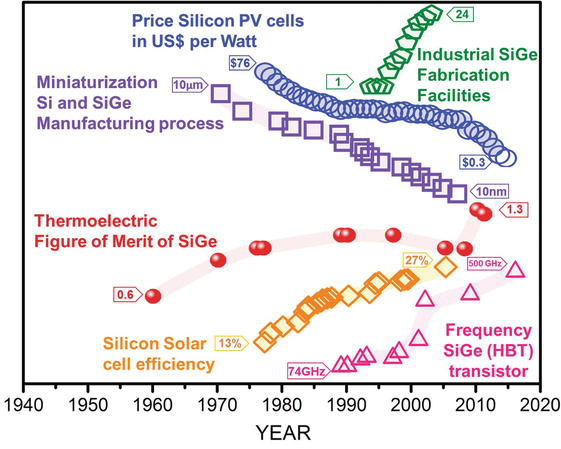![Figure 1. (a) Total world energy consumption sorted by energy source between the period 1990 and 2040. Dotted lines for coal (black) and renewables (green) show the predicted effects of the USA Clean Power Plan (CPP) regulation. (b) World net electricity generation predictions sorted by energy source, for the period of 2012–2040. Both figures are reprinted with permission from Ref. [3]. Copyright 2016. Figure 1. (a) Total world energy consumption sorted by energy source between the period 1990 and 2040. Dotted lines for coal (black) and renewables (green) show the predicted effects of the USA Clean Power Plan (CPP) regulation. (b) World net electricity generation predictions sorted by energy source, for the period of 2012–2040. Both figures are reprinted with permission from Ref. [3]. Copyright 2016.](https://www.internano.org/sites/internano.org/files/styles/large/public/20170531_er4618_Figure1.png?itok=FMfwf72z)
Although silicon is mainly associated with microchip devices and advances in computing, the alloy that silicon forms with germanium can be used as a thermoelectric material, which is, in the presence of a gradient of temperature, able to generate an electrical voltage and vice versa. This thermoelectric effect has been long known. Nevertheless, it has not been widely used because of its modest efficiency. In recent years, the interest on thermoelectricity has revamped due to the use of thermoelectric devices for micro‐energy harvesting or as a large‐scale conversion of residual heat into electricity. This increase in the research on thermoelectrics is mostly due to the impact nanostructuration has on improving the efficiency of these materials, which has been increased almost a factor of three over the last 20 years. The purpose of this chapter is to highlight the ways in which silicon‐germanium has improved its efficiency by nanostructuration.
Considering the decreasing fossil fuels and increasing energy demand worldwide, a pressing need for improved direct thermal (wasted heat) into electrical energy conversion is imposed. The wasted heat comes from the energy transportation, vehicles, electricity generating sources, industry, etc., which tampers the actual efficiency of the initial resources. For instance, around 30% of the energy obtained from the fuel of a car is actually used in its movement. The other 70% is lost in the form of heat, friction, and cooling the car. Furthermore, it is completely reasonable to look for alternative energy technologies to reduce our dependence on fossil fuels and greenhouse gas effects. This necessity has fostered multiple lines of research, including the conversion of thermal energy through thermoelectricity [2]. As an example, the most recent International Energy Outlook 2016 (IEO2016) [3] prepared by the USA Energy Information Administration shows the energy production predictions for the year 2040, based on the data recorded previously (Figure 1a). It is shown that the total world consumption of energy will increase a 48% from 2012 to 2040. Renewable energies are the fastest‐growing energy sources over the predicted period, with a foreseen increase in their consumption of around 2.6%/year between 2012 and 2040. In Figure 1a, CPP refers to a Clean Power Plan (CPP), which is a USA regulation that aims to reduce carbon dioxide emissions from electric power generation by 32% within 25 years, relative to the levels of 2005 in the USA.
Focusing on the future of the different sources of energies, that is Figure 1b, world net electricity generation is envisioned to increase by 69%, in 2040, going from 21.6 trillion kilowatt hours (1012 kWh) registered in 2012 to 25.8 trillion kWh predicted for 2020 and to 36.5 trillion kWh in 2040. It is worth noting that, even with initiatives as the CPP, or the development predicted for renewable energies, fossil fuels will still account for a 78% of the energy used in 2040.
For these reasons, in late 2015, representatives from 185 countries and the European Union (EU) met in Paris to reach a commitment to addressing climate change, called Paris‐COP21. This worldwide engagement is expected to drive innovation in renewable energies, battery storage, energy efficiency, and energy recovery. One of the main conclusions obtained in the conference is that climate change is often discussed as a single problem, but solving it will require a wide variety of solutions [4]. The EU budget for low carbon‐related research under Horizon 2020 has been effectively doubled for the period 2014–2020, and the EU has promised to invest at least 35% of Horizon 2020 resources into climate‐related activities [5]. In the United States, hundreds of major companies, including energy‐related companies such as ExxonMobil, Shell, DuPont, Rio Tinto, Berkshire Hathaway Energy, Cal‐pine, and Pacific Gas and Electric Company, have supported the Paris‐COP21 [6]. In the coming decades, there will be a need for more energy‐efficient technologies, easily compatible with the non‐renewable energies (that will not disappear in the near future as it can be seen in Figure 1b). Certainly, thermoelectric materials and especially thin films are interesting players in this scenario. Its ability to convert waste heat into electricity regardless of the source of heat generation, stability over time, and the ability to generate electricity locally without the need for transportation are some of its many advantages.
Likewise, Figure 2 and Table 1 show some of the most outstanding historical facts and current state of the art of Si and SiGe in thermoelectric, microelectronic, and photovoltaic applications.

Reference:
Silicon‐Germanium (SiGe) Nanostructures for Thermoelectric Devices: Recent Advances and New Approaches to High Thermoelectric Efficiency | InTechOpen, Published on: 2017-05-31. Authors: Jaime Andrés Pérez‐Taborda, Olga Caballero‐Calero and Marisol Martín‐González
